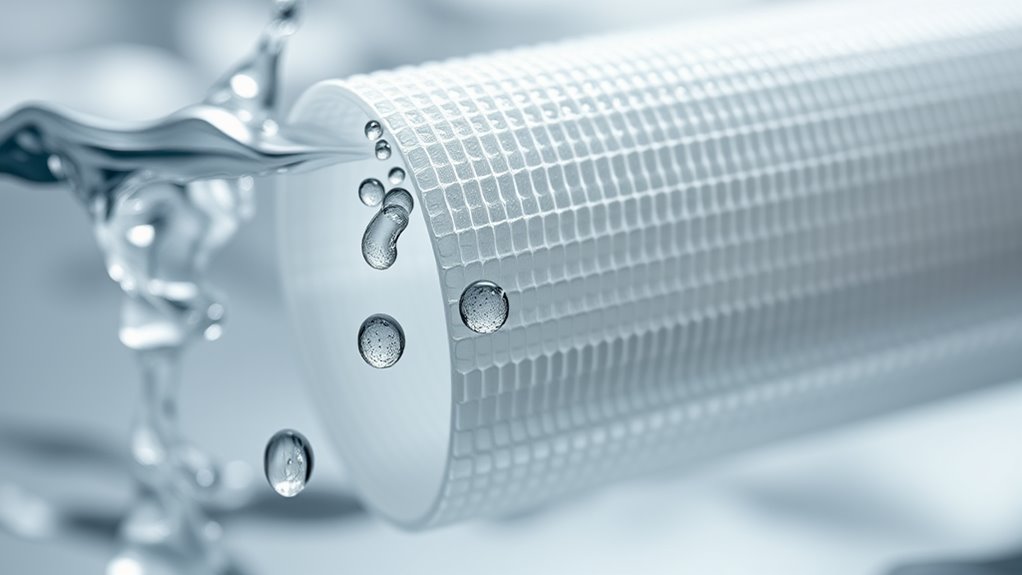
An RO membrane is a high-precision filter that separates pure water from impurities using high pressure. It's made of materials like polyamide and polysulfone, with tiny pores measuring about 0.0001 microns. As water is forced through, contaminants are rejected, resulting in purified water collected in a central channel. This technology achieves over 99% removal of more than 100 pollutants, making it essential for drinking water, industrial processes, and agriculture. There's much more to uncover about its applications and design.
When you consider water purification technologies, the reverse osmosis (RO) membrane stands out as an important element in effectively separating pure water from contaminants. This semi-permeable barrier plays a significant role in various applications, including drinking water purification, industrial processes, and agricultural irrigation.
RO membranes are commonly made from materials like polyamide and polysulfone, each contributing to the membrane's efficiency and durability. With a pore size of approximately 0.0001 microns, these membranes allow water molecules to pass while blocking a wide range of impurities, including dissolved salts and harmful contaminants.
The structure of an RO membrane consists of multiple layers that work together to achieve ideal filtration. The polyamide layer acts as the primary filtration barrier, selectively allowing water to permeate while retaining contaminants. Below this, the polysulfone layer provides necessary structural support, guaranteeing the membrane can withstand the pressure applied during operation.
The multi-layered structure of RO membranes ensures optimal filtration, balancing effective contaminant retention with necessary structural support.
A fabric support layer further enhances the membrane's integrity, making it robust enough for various water treatment tasks. Different configurations, including spiral-wound, flat sheet, and hollow fiber designs, cater to specific applications, each offering unique advantages depending on the scale and requirements of the water purification system.
Understanding the mechanism of RO membranes is important to appreciate their effectiveness. High pressure forces water through the membrane, where the tiny pores facilitate the permeation of water molecules while rejecting larger impurities. This process is essential for achieving high-quality water through the use of RO membranes.
This process results in the collection of purified water through a central channel or core tube, while a concentrate stream is generated, which contains the rejected contaminants and excess salts. This dual-stream system not only maximizes efficiency but also guarantees a considerable reduction in total dissolved solids (TDS), achieving up to 99% removal of over 100 contaminants in some cases.
Among the various types of RO membranes, spiral-wound membranes are predominant in large-scale systems like municipal plants and industrial desalination facilities. Flat sheet membranes are typically utilized for laboratory testing and development, while hollow fiber membranes are ideal for compact and portable applications.
Thin film composite (TFC) membranes are favored for their enhanced performance and longevity, whereas older cellulose acetate membranes have largely been phased out in favor of these more efficient alternatives.
The application of RO membranes in water purification is extensive. They're important in producing safe drinking water by effectively removing harmful substances and dissolved salts.
In industrial settings, where high-quality water is necessary, such as in pharmaceuticals and semiconductor manufacturing, RO membranes are indispensable. They also play an important role in agriculture, guaranteeing that irrigation systems deliver clean water to crops, thereby enhancing yield and quality.
Ultimately, the efficiency and effectiveness of RO membranes in removing contaminants can't be overstated. By achieving high levels of water purity and considerably reducing TDS, they provide a reliable solution to various water treatment challenges.
Their advanced design and function make RO membranes a cornerstone of modern water purification technologies, guaranteeing access to clean, safe water for diverse applications.
Conclusion
To sum up, the RO membrane acts as a vigilant guardian, selectively allowing only pure water to pass while keeping impurities at bay. Just as a sieve separates grains from chaff, this membrane's microscopic pores filter out contaminants, ensuring you get clean, safe water. By harnessing the power of reverse osmosis, you're not just quenching your thirst; you're embracing a technology that transforms your water source into an oasis, free from the burdens of pollutants and unwanted substances.



